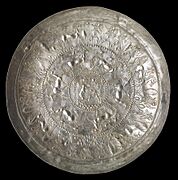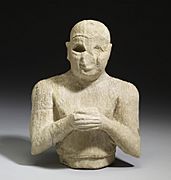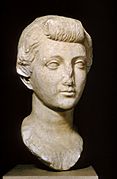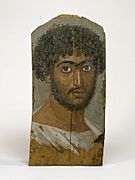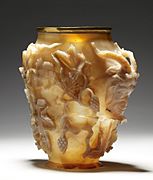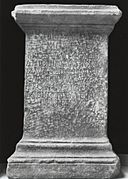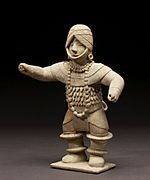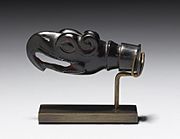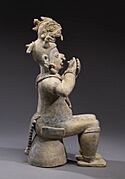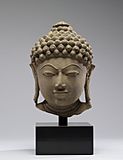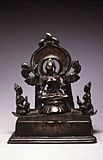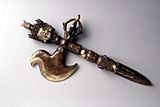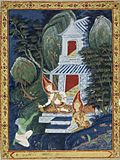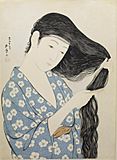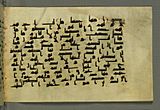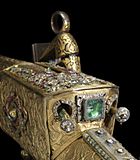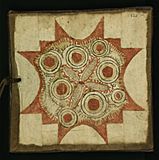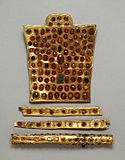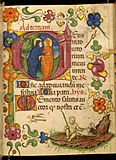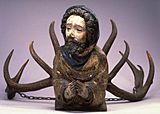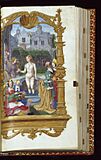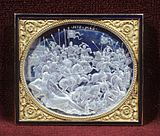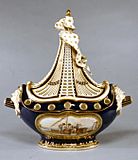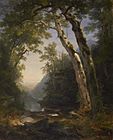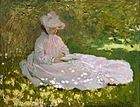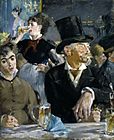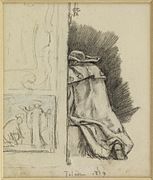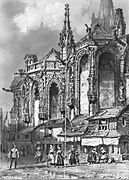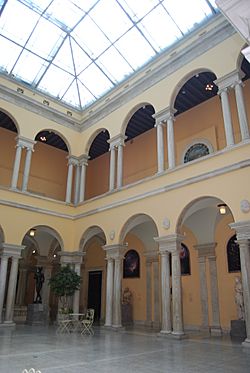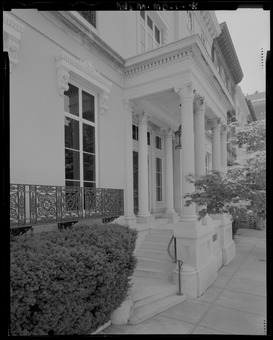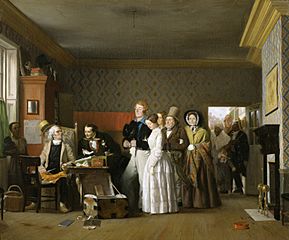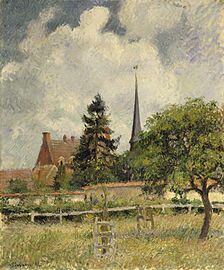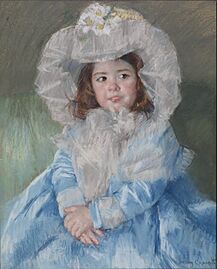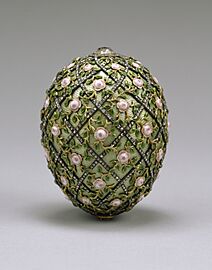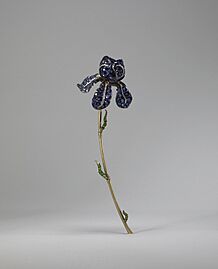Walters Art Museum facts for kids
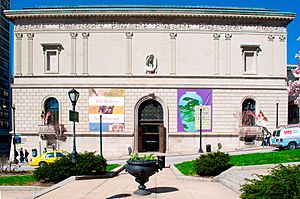
Museum entrance, North Charles Street, Baltimore
|
|
| Former name | The Walters Art Gallery |
|---|---|
| Established | 1934 |
| Location | Mount Vernon, Baltimore, Maryland, U.S. |
| Type | Art museum |
| Public transit access | BaltimoreLink routes Green, Pink, Silver, 51, 95, 103, 410, 411 Charm City Circulator Purple Route |
The Walters Art Museum is a public art museum in Baltimore, Maryland. It opened in 1934. The museum holds amazing collections of art and sculptures. These were gathered by two important American collectors: William Thompson Walters and his son Henry Walters.
William Walters started collecting art in 1861 when he moved to Paris. His son, Henry, added to the collection. Henry also made plans for the museum building. In the late 1800s, Henry let people in Baltimore see his family's growing art collection. He later built a beautiful stone building for the art. This building was finished in 1909.
When Henry Walters passed away in 1931, he gave his entire collection to the City of Baltimore. This included over 22,000 artworks, the museum building, and his home next door. He wanted it to be "for the benefit of the public." The collection has art from ancient Egypt, Greek sculptures, and Roman items. It also includes medieval ivories, old European paintings, and Art Deco jewelry.
In 2000, the museum changed its name from "The Walters Art Gallery" to "The Walters Art Museum." This showed it was a large public place. The main building was also updated between 1998 and 2001. Since October 1, 2006, the museum has offered free admission to everyone. This was made possible by grants from Baltimore City. In 2012, the museum shared nearly 20,000 images of its art online for free. This was one of the biggest art releases by any museum.
Exploring the Art Collections
The Walters Art Museum has many different types of art from all over the world. Let's explore some of its amazing collections!
Ancient Art
The museum's ancient art collection features items from Egypt, Nubia, Greece, Rome, and the Near East.
- You can see two huge statues of the Egyptian lion goddess Sekhmet.
- There's also the Walters Mummy.
- Look for Greek gold jewelry and Roman portrait heads.
- The collection also includes a Roman bronze banquet couch.
-
Al Fayum mummy portrait, Roman Egypt, c. A.D. 175
Art from the Ancient Americas
In 1911, Henry Walters bought nearly 100 gold items from Panama. This started the museum's collection of ancient American art.
- The museum has pottery and stone works from Mexico, Central America, and South America.
- These include pieces from the Olmec, Aztec, and Maya cultures.
- You can also see art from the Moche and Inca peoples.
-
Whistle from Colima, Mexico, c. 300 B.C. - A.D. 200
-
Jama Coaque figure, from Manabí Province, Ecuador, c. 300 BCE-800 CE
Asian Art
The Asian art collection was put together by William and Henry Walters.
- It includes Japanese weapons and armor.
- You can also see Chinese and Japanese porcelains.
- A special piece is a Cambodian bronze of Avalokiteshvara from the 12th or 13th century.
- The museum has the oldest surviving Chinese wooden Buddha statue (late 6th century AD).
- It also has one of the best collections of Thai art in the world.
-
Head of a Jain Tirthankara, India, 10th century
-
'Mandala of Padmavati' - bronze statue of Goddess Padmavati, India, 11th century
-
Brass idol of tirthankar Parshvanatha, India, 16th century
-
Detail of Ming dynasty wood and lacquer Guanyin
-
15th-century Tibet, a ritual knife and chopper
-
19th-century Thai illustration of Vessantara Jataka, Ch 10
-
18th-century Chinese jar with dragon
-
Hashiguchi Goyo, Woman in Blue Combing Her Hair, woodblock print, Japan, 1920
Islamic Art
The Walters has Islamic art made from many different materials.
- Look for a silver bowl from Iran (ancient Persia) from the 7th century.
- There's a 13th-century candlestick from Egypt.
- You can also see 16th-century mausoleum doors with detailed wood carvings.
- A 17th-century silk sash from the Mughal Empire in India is also on display.
- The museum has many Islamic manuscripts. These include a 15th-century Koran from northern India.
-
Early Qur'an page in Kufic script, 9th century
-
The Death of Darius, Mughal miniature from Akbar's Khamsa of Nizami, 1595
-
Detail of an 18th-century ceremonial jeweled Turkish rifle
Medieval European Art
Henry Walters collected art from the Middle Ages. This is one of the museum's most famous collections.
- It's considered one of the best medieval art collections in the United States.
- You can see metalwork, sculptures, and stained glass.
- The collection is known for its ivories and illuminated manuscripts.
- A special item is the Byzantine agate Rubens Vase.
- There's also an ivory carving of the "Virgin of Tenderness" from Egypt (6th or 7th century).
- Sculpted heads from the royal Abbey of St. Denis are rare examples of early Gothic art.
-
Hunnish set of horse trappings, 4th century
-
Leaf from Barbavara Book of Hours, Milan c. 1440
-
15th century Nottingham alabaster panel of the Resurrection of Christ
-
German chandelier, red deer antler and wood, 15th century
Renaissance, Baroque, and 18th-Century European Art
This collection includes paintings, sculptures, and furniture from the Renaissance and Baroque periods.
- Important paintings include Donor with Saint John the Baptist by Hugo van der Goes.
- You can also see The Ideal City by Fra Carnevale.
- The museum has one of only ten surviving Sèvres pot-pourri vase in the shape of a ships.
-
Madonna of the Candelabra (c. 1513) by Raphael.
-
The Battle of Pavia, engraved on rock crystal, 1530s
-
Giovanni Battista Tiepolo, Scipio Africanus Freeing Massiva, c. 1720
-
The Sacrifice of Polyxena, Giambattista Pittoni
-
Pompeo Batoni, Portrait of Cardinal Prospero Colonna di Sciarra, c. 1750
19th-Century European Art
William and Henry Walters collected works by French artists from the late 1800s.
- Key pieces include Odalisque with Slave by Ingres.
- You can also see Springtime by Claude Monet.
- Another highlight is The Café Concert by Édouard Manet.
- Henry Walters was very interested in fancy 18th-century French art.
- The museum has Sèvres porcelain made for the Royal Court at Versailles.
- The collection also features Art Nouveau jewelry by René Lalique.
- There are also jeweled objects by Fabergé, including two Russian Imperial Easter eggs.
-
Raby Castle, the Seat of the Earl of Darlington (1817) by Joseph Mallord William Turner
-
The Catskills (1859) by Asher Brown Durand.
-
News from Afar (1860) by Alfred Stevens
-
Springtime (1872) by Claude Monet.
-
The Café-Concert (ca. 1879) by Édouard Manet.
-
The Terrace at Saint-Germain, Spring (1875) by Alfred Sisley.
Drawings
The museum also has a collection of drawings.
-
Confessional, Toledo, by Félicien Rops, 1889
Museum Buildings
Original Main Building (1905–1909)
Henry Walters' first gallery was designed by architect William Adams Delano. It was built between 1904 and 1909. The outside looks like the Hôtel Pourtalès in Paris. The inside was inspired by a 17th-century building in Genoa. Today, art from the Renaissance and Baroque periods is shown here.
Centre Street Annex Building (1974)
This newer building opened in 1974. It was designed in a modern style. Between 1998 and 2001, it was updated with a glass entrance. This new entrance made it easier for visitors to enter. It also added a café, gift shop, and library. This building houses the ancient, medieval, and 19th-century European collections. The museum's art conservation lab is also here.
Hackerman House (1850/1991)
This beautiful house was built between 1848 and 1850. It was designed by architect John Rudolph Niernsee. It's known as one of the most elegant houses in Baltimore. Famous guests like the future King Edward VII of England once visited. In 1991, the house reopened as "Hackerman House." It now displays the museum's Asian art collection. A special connecting hallway links it to the main museum building.
Gallery
Here are some more artworks from the museum's collection.
-
Ethiopian miniature of John the Evangelist, c. 1540
-
George Washington (1825) by Gilbert Stuart
-
The Church at Eragny (1884) by Camille Pissarro
-
Margot in Blue (1902) by Mary Cassatt.
-
Rose Trellis Imperial Easter Egg (1907) by Peter Carl Fabergé.
-
Pendant with a Lion, Flemish, (between 1600 and 1650) Baroque
See also
 In Spanish: Walters Art Museum para niños
In Spanish: Walters Art Museum para niños
- Collaboration Between Walters Art Museum and Wikimedia Commons
- Archimedes Palimpsest
- Baltimore Museum of Art
- Charles Street
- Washington Monument


